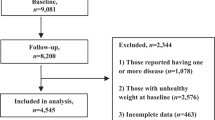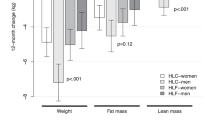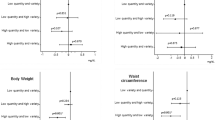Abstract
Background/Objectives:
To compare the effects of two dietary approaches on changes in dietary intakes and body weight: (1) an approach emphasizing nonrestrictive messages directed toward the inclusion of fruits and vegetables (HIFV) and (2) another approach using restrictive messages to limit high-fat foods (LOFAT).
Subjects/Methods:
A total of 68 overweight–obese postmenopausal women were randomly assigned to one of the two dietary approaches. The 6-month dietary intervention included three group sessions and ten individual sessions with a dietitian. Dietary food intake and anthropometric variables were measured at baseline, at 3 months and at 6 months.
Results:
Energy density decreased in both groups after the intervention compared with baseline (HIFV, −0.3±0.2 kcal/g; LOFAT, −0.3±0.3 kcal/g; P<0.0001). Although body weight decreased significantly in both groups after the intervention compared with baseline (HIFV, −1.6±2.9 kg; LOFAT, −3.5±2.9 kg; P<0.0001), women in the LOFAT group lost significantly more body weight than women in the HIFV group (P=0.01). In the HIFV group, the decrease in energy density was found to be an independent predictor of body weight loss.
Conclusions:
The LOFAT approach induces more weight loss than does the HIFV approach in our sample of overweight–obese postmenopausal women.
This is a preview of subscription content, access via your institution
Access options
Subscribe to this journal
Receive 12 print issues and online access
$259.00 per year
only $21.58 per issue
Buy this article
- Purchase on Springer Link
- Instant access to full article PDF
Prices may be subject to local taxes which are calculated during checkout

Similar content being viewed by others
References
American Diabetes Association. Diagnosis and Classification of Diabetes Mellitus (2006). Diabetes Care 29 (Suppl 1), S43–S48.
Appel LJ, Champagne CM, Harsha DW, Cooper LS, Obarzanek E, Elmer PJ et al. (2003). Effects of comprehensive lifestyle modification on blood pressure control: main results of the PREMIER clinical trial. JAMA 289, 2083–2093.
Asbeck I, Mast M, Bierwag A, Westenhofer J, Acheson KJ, Muller MJ (2002). Severe underreporting of energy intake in normal weight subjects: use of an appropriate standard and relation to restrained eating. Public Health Nutr 5, 683–690.
Astrup A, Astrup A, Buemann B, Flint A, Raben A (2002). Low-fat diets and energy balance: how does the evidence stand in 2002? Proc Nutr Soc 61, 299–309.
Bell EA, Castellanos VH, Pelkman CL, Thorwart ML, Rolls BJ (1998). Energy density of foods affects energy intake in normal-weight women. Am J Clin Nutr 67, 412–420.
Black AE (2000). Critical evaluation of energy intake using the Goldberg cut-off for energy intake:basal metabolic rate. A practical guide to its calculation, use and limitations. Int J Obes Relat Metab Disord 24, 1119–1130.
Chaput JP, Pelletier C, Despres JP, Lemieux S, Tremblay A (2007). Metabolic and behavioral vulnerability related to weight regain in reduced-obese men might be prevented by an adequate diet–exercise intervention. Appetite 49, 691–695.
Cole JC, Grossman I, Prilliman C, Hunsaker E (2003). Multimethod validation of the Beck Depression Inventory–II and Grossman–Cole Depression Inventory with an inpatient sample. Psychol Rep 93, 1115–1129.
Cooper Z, Fairburn CG (2001). A new cognitive behavioural approach to the treatment of obesity. Behav Res Ther 39, 499–511.
Dansinger ML, Gleason JA, Griffith JL, Selker HP, Schaefer EJ (2005). Comparison of the Atkins, Ornish, Weight Watchers, and Zone diets for weight loss and heart disease risk reduction: a randomized trial. JAMA 293, 43–53.
Deibert P, Konig D, Vitolins MZ, Landmann U, Frey I, Zahradnik HP et al. (2007). Effect of a weight loss intervention on anthropometric measures and metabolic risk factors in pre- versus postmenopausal women. Nutr J 6, 31.
Doucet E, Imbeault P, St Pierre S, Almeras N, Mauriege P, Richard D et al. (2000). Appetite after weight loss by energy restriction and a low-fat diet-exercise follow-up. Int J Obes Relat Metab Disord 24, 906–914.
Ello-Martin JA, Roe LS, Ledikwe JH, Beach AM, Rolls BJ (2007). Dietary energy density in the treatment of obesity: a year-long trial comparing 2 weight-loss diets. Am J Clin Nutr 85, 1465–1477.
Epstein LH, Gordy CC, Raynor HA, Beddome M, Kilanowski CK, Paluch R (2001). Increasing fruit and vegetable intake and decreasing fat and sugar intake in families at risk for childhood obesity. Obes Res 9, 171–178.
Franz MJ, VanWormer JJ, Crain AL, Boucher JL, Histon T, Caplan W et al. (2007). Weight-loss outcomes: a systematic review and meta-analysis of weight-loss clinical trials with a minimum 1-year follow-up. J Am Diet Assoc 107, 1755–1767.
Goldberg GR, Black AE, Jebb SA, Cole TJ, Murgatroyd PR, Coward WA et al. (1991). Critical evaluation of energy intake data using fundamental principles of energy physiology: 1. Derivation of cut-off limits to identify under-recording. Eur J Clin Nutr 45, 569–581.
Goulet J, Lamarche B, Nadeau G, Lemieux S (2003). Effect of a nutritional intervention promoting the Mediterranean food pattern on plasma lipids, lipoproteins and body weight in healthy French–Canadian women. Atherosclerosis 170, 115–124.
Goulet J, Nadeau G, Lapointe A, Lamarche B, Lemieux S (2004). Validity and reproducibility of an interviewer-administered food frequency questionnaire for healthy French–Canadian men and women. Nutr J 3, 13.
Hamman RF, Wing RR, Edelstein SL, Lachin JM, Bray GA, Delahanty L et al. (2006). Effect of weight loss with lifestyle intervention on risk of diabetes. Diabetes Care 29, 2102–2107.
Hart KE, Chiovari P (1998). Inhibition of eating behavior: negative cognitive effects of dieting. J Clin Psychol 54, 427–430.
Knowler WC, Barrett-Connor E, Fowler SE, Hamman RF, Lachin JM, Walker EA et al. (2002). Reduction in the incidence of type 2 diabetes with lifestyle intervention or metformin. N Engl J Med 346, 393–403.
Laessle RG, Tuschl RJ, Kotthaus BC, Pirke KM (1989). A comparison of the validity of three scales for the assessment of dietary restraint. J Abnorm Psychol 98, 504–507.
Ledikwe JH, Blanck HM, Kettel KL, Serdula MK, Seymour JD, Tohill BC et al. (2006). Dietary energy density is associated with energy intake and weight status in US adults. Am J Clin Nutr 83, 1362–1368.
Ledikwe JH, Blanck HM, Khan LK, Serdula MK, Seymour JD, Tohill BC et al. (2005). Dietary energy density determined by eight calculation methods in a nationally representative United States population. J Nutr 135, 273–278.
Lemoine S, Rossell N, Drapeau V, Poulain M, Garnier S, Sanguignol F et al. (2007). Effect of weight reduction on quality of life and eating behaviors in obese women. Menopause 14, 432–440.
Lohman T, Martorel R, Roche A (1988). Standardization of Anthropometric Measurements. Human Kinetics: Champaign, IL, 39–80.
Major GC, Piche ME, Bergeron J, Weisnagel SJ, Nadeau A, Lemieux S (2005). Energy expenditure from physical activity and the metabolic risk profile at menopause. Med Sci Sports Exerc 37, 204–212.
Mond JM, Hay PJ, Rodgers B, Owen C, Beumont PJ (2004). Validity of the Eating Disorder Examination Questionnaire (EDE-Q) in screening for eating disorders in community samples. Behav Res Ther 42, 551–567.
National Institutes of Health (1998). Clinical Guidelines on the Identification, Evaluation, and Treatment of Overweight and Obesity in Adults—The Evidence Report. Obes Res 6 (Suppl 2), 51S–209S.
Phelan S, Wadden TA, Berkowitz RI, Sarwer DB, Womble LG, Cato RK et al. (2007). Impact of weight loss on the metabolic syndrome. Int J Obes (London) 31, 1442–1448.
Pierce JP, Newman VA, Natarajan L, Flatt SW, Al Delaimy WK, Caan BJ et al. (2007). Telephone counseling helps maintain long-term adherence to a high-vegetable dietary pattern. J Nutr 137, 2291–2296.
Ratner R, Goldberg R, Haffner S, Marcovina S, Orchard T, Fowler S et al. (2005). Impact of intensive lifestyle and metformin therapy on cardiovascular disease risk factors in the diabetes prevention program. Diabetes Care 28, 888–894.
Rolls BJ, Bell EA, Thorwart ML (1999). Water incorporated into a food but not served with a food decreases energy intake in lean women. Am J Clin Nutr 70, 448–455.
Rolls BJ, Ello-Martin JA, Tohill BC (2004). What can intervention studies tell us about the relationship between fruit and vegetable consumption and weight management? Nutr Rev 62, 1–17.
Sacks FM, Bray GA, Carey VJ, Smith SR, Ryan DH, Anton SD et al. (2009). Comparison of weight-loss diets with different compositions of fat, protein, and carbohydrates. N Engl J Med 360, 859–873.
Stunkard AJ, Messick S (1985). The Three-Factor Eating Questionnaire to measure dietary restraint, disinhibition and hunger. J Psychosom Res 29, 71–83.
Yao M, Roberts SB (2001). Dietary energy density and weight regulation. Nutr Rev 59, 247–258.
Acknowledgements
We thank the participants for excellent collaboration and to the staff of the Institute of Nutraceuticals and Functional Foods and the Diabetes Research Unit for their contribution to this study. We especially thank Louise Corneau, Danielle Aubin, Claire Julien, Michèle Fournier, Alexandra Bédard and Annie Bouchard-Mercier for helping in the collection and analysis of the data. This study was supported by the Canadian Diabetes Association (CDA). Annie Lapointe is the recipient of a studentship from the Canadian Institutes of Health Research (CIHR) and the Fonds de la Recherche en Santé du Québec (FRSQ). Véronique Provencher is a CIHR and a CDA fellow.
Author information
Authors and Affiliations
Corresponding author
Rights and permissions
About this article
Cite this article
Lapointe, A., Weisnagel, S., Provencher, V. et al. Using restrictive messages to limit high-fat foods or nonrestrictive messages to increase fruit and vegetable intake: what works better for postmenopausal women?. Eur J Clin Nutr 64, 194–202 (2010). https://doi.org/10.1038/ejcn.2009.135
Received:
Revised:
Accepted:
Published:
Issue Date:
DOI: https://doi.org/10.1038/ejcn.2009.135
Keywords
This article is cited by
-
Effectiveness of dietary interventions among adults of retirement age: a systematic review and meta-analysis of randomized controlled trials
BMC Medicine (2014)
-
Association of behaviour change techniques with effectiveness of dietary interventions among adults of retirement age: a systematic review and meta-analysis of randomised controlled trials
BMC Medicine (2014)
-
Weight loss effects from vegetable intake: a 12-month randomised controlled trial
European Journal of Clinical Nutrition (2014)



